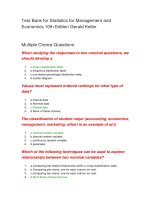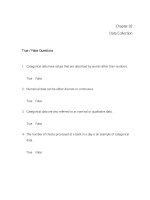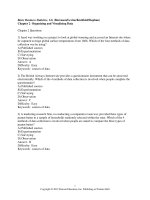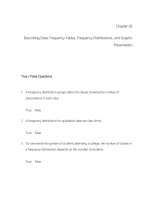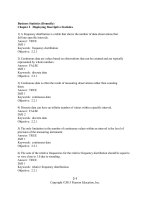Statistics salkind 4e test bank ch01
Bạn đang xem bản rút gọn của tài liệu. Xem và tải ngay bản đầy đủ của tài liệu tại đây (264 KB, 12 trang )
Chapter 1: Statistics or Sadistics? It’s Up to You
Test Bank
MULTIPLE CHOICE
1. When humans first realized that counting was a good idea, this became a useful skill for
people to have:
a. Knowing the alphabet
b. Asking questions
c. Collecting information
d. Making decisions
ANS: C
PTS: 1
REF: A 5-Minute History of Statistics
COG: Knowledge
DIF: Easy
OBJ: What statistics is all about
2. In early times, once numbers became part of the human language, the next step was to attach
numbers to _______.
a. Outcomes
b. Letters
c. Places
d. Time
ANS: A
PTS: 1
REF: A 5-Minute History of Statistics
COG: Knowledge
DIF: Easy
OBJ: What statistics is all about
3. After the first set of data having to do with populations was collected during the 17th century,
scientists needed to develop
a. General tools to answer general questions
b. General tools to answer specific questions
c. Specific tools to answer general questions
d. Specific tools to answer specific questions
ANS: D
PTS: 1
REF: A 5-Minute History of Statistics
COG: Knowledge
DIF: Easy
OBJ: What statistics is all about
4. The most popular spreadsheet program that has been used as a tool for conducting basic and
some advanced statistical analyses is _______.
a. SPSS
b. Microsoft Word
c. Mini Tab
d. Excel
ANS: D
PTS: 1
OBJ: Why you should take statistics
DIF: Easy
COG: Knowledge
REF: And Why Excel?
5. Today, statisticians in many different professional areas find themselves using _______
techniques to answer different questions.
a. Varied
b. New
c. The same
d. Experimental
ANS: C
PTS: 1
REF: A 5-Minute History of Statistics
COG: Knowledge
DIF: Easy
OBJ: Why you should take statistics
6. Statistics describes a set of _______ that are used for describing, organizing, and interpreting
information.
a. Statements
b. Rules and exceptions
c. Tools and techniques
d. Numbers and letters
ANS: C
PTS: 1
REF: Statistics: What It Is (and Isn’t)
COG: Knowledge
DIF: Easy
OBJ: What statistics is all about
7. _______ statistics involve collecting, organizing, and summarizing data.
a. Experimental
b. Descriptive
c. Inferential
d. Organizational
ANS: B
PTS: 1
REF: What Are Descriptive Statistics?
COG: Knowledge
DIF: Easy
OBJ: What statistics is all about
8. Inferential statistics involve _______ the data.
a. Organizing
b. Balancing
c. Editing
d. Interpreting
ANS: D
PTS: 1
REF: What Are Inferential Statistics?
COG: Comprehension
DIF: Easy
OBJ: What statistics is all about
9. The type of descriptive statistic that tells you the most popular or most frequent choice from a
number of choices is the _______.
a. Median
b. Mode
c. Mean
d. Average
ANS: B
PTS: 1
REF: What Are Descriptive Statistics?
COG: Knowledge
DIF: Easy
OBJ: What statistics is all about
10. The descriptive statistic that is also referred to as the average is the _______.
a. Median
b. Mode
c. Mean
d. Descriptor
ANS: C
PTS: 1
REF: What Are Descriptive Statistics?
COG: Knowledge
DIF: Easy
OBJ: What statistics is all about
11. _______ statistics are often (but not always) the next step after you have some basic
understanding of data.
a. Descriptive
b. Inferential
c. Experimental
d. Observational
ANS: B
PTS: 1
REF: What Are Inferential Statistics?
COG: Knowledge
DIF: Easy
OBJ: What statistics is all about
12. _______ is to a smaller group of data as population is to a larger group of data.
a. Micro group
b. Mini group
c. Micro data
d. Sample
ANS: D
PTS: 1
REF: What Are Inferential Statistics?
COG: Comprehension
DIF: Medium
OBJ: What statistics is all about
13. Descriptive and inferential statistics work hand in hand, and which one you use and when
depends on
a. The question you want answered
b. The methods you choose for investigation
c. The sample you select
d. The population you choose
ANS: A
PTS: 1
OBJ: How to succeed in this course
DIF: Easy
COG: Knowledge
REF: In Other Words . . .
14. What term is used to describe the science of organizing and analyzing information to make the
information more easily understood?
a. Analysis
b. Data
c. Interpretation
d. Statistics
ANS: D
PTS: 1
REF: Statistics: What It Is (and Isn’t)
COG: Knowledge
DIF: Easy
OBJ: What statistics is all about
15. Which of the following individuals used statistical methods during the 17th century to study
the intelligence of his family members?
a. Charles Darwin
b. Francis Galton
c. Isaac Newton
d. Alfred Binet
ANS: B
PTS: 1
REF: A 5-Minute History of Statistics
COG: Knowledge
DIF: Easy
OBJ: What statistics is all about
16. Which of the following would be used to describe the type of statistical methods used to
organize and describe the characteristics of a collection of data?
a. Inferential statistics
b. Descriptive statistics
c. Sampling methods
d. Population methods
ANS: B
PTS: 1
REF: What Are Descriptive Statistics?
COG: Knowledge
DIF: Easy
OBJ: What statistics is all about
17. When did the first collection of a set of data pertaining to populations occur?
a. 15th century
b. 17th century
c. 19th century
d. 21st century
ANS: B
PTS: 1
REF: A 5-Minute History of Statistics
COG: Knowledge
DIF: Easy
OBJ: What statistics is all about
18. Who popularized the use of the correlation coefficient?
a. Charles Darwin
b. Neil Salkind
c. Francis Galton
d. R. A. Fisher
ANS: C
PTS: 1
REF: A 5-Minute History of Statistics
COG: Knowledge
DIF: Easy
OBJ: What statistics is all about
19. What term is defined as a set of tools and techniques used for describing, organizing, and
interpreting data?
a. Inference
b. Population
c. Sample
d. Statistics
ANS: D
PTS: 1
REF: Statistics: What It Is (and Isn’t)
COG: Knowledge
DIF: Easy
OBJ: What statistics is all about
20. If your professor tells you, “If you don’t start with reliable data, you’ll end up with unreliable
results,” what does he or she mean?
a. A bird in the hand is worth two in the bush.
b. A watched pot never boils.
c. Don’t cry over spilt milk.
d. Garbage in, garbage out.
ANS: D
PTS: 1
REF: A 5-Minute History of Statistics
COG: Comprehension
DIF: Easy
OBJ: How to succeed in this course
21. What will you need to complete most statistical analyses?
a. A personal computer
b. Large computer mainframe
c. A slide rule
d. A highly trained technician
ANS: A
PTS: 1
REF: A 5-Minute History of Statistics
COG: Knowledge
DIF: Easy
OBJ: How to succeed in this course
22. In what century was the simplest test for examining differences between two groups first
advanced?
a. 17th century
b. 18th century
c. 19th century
d. 20th century
ANS: D
PTS: 1
REF: A 5-Minute History of Statistics
COG: Knowledge
DIF: Easy
OBJ: What statistics is all about
23. Inferential statistics is most often used for which of the following?
a. Summarizing data
b. Organizing data
c. Interpreting data
d. Collecting data
ANS: C
PTS: 1
REF: What Are Inferential Statistics?
COG: Knowledge
DIF: Easy
OBJ: What statistics is all about
24. Which of the following is NOT a use of descriptive statistics?
a. Organizing data
b. Interpreting data
c. Summarizing data
d. Collecting data
ANS: B
PTS: 1
REF: What Are Descriptive Statistics?
COG: Knowledge
DIF: Easy
OBJ: What statistics is all about
25. What type of statistics is used to organize and describe the characteristics of a collection of
data?
a. Inferential
b. Descriptive
c. Ordinal
d. Nominal
ANS: B
PTS: 1
REF: What Are Descriptive Statistics?
COG: Knowledge
DIF: Easy
OBJ: What statistics is all about
26. What is a collection of information also called?
a. Data set
b. Sample statistic
c. Descriptive statistic
d. Population subset
ANS: A
PTS: 1
REF: What Are Descriptive Statistics?
COG: Knowledge
DIF: Easy
OBJ: What statistics is all about
27. When are descriptive measures most often used?
a. To describe how often something occurs
b. To determine if a sample is representative of a population
c. To predict an outcome
d. To determine the effect of an intervention
ANS: A
PTS: 1
REF: What Are Descriptive Statistics?
COG: Knowledge
DIF: Easy
OBJ: What statistics is all about
28. How are inferential statistics most often used?
a. To infer to the quality of data collected
b. To organize and describe data
c. To make inferences from the sample to the population
d. To plot the data
ANS: C
PTS: 1
REF: What Are Inferential Statistics?
COG: Knowledge
DIF: Easy
OBJ: What statistics is all about
29. What is the small subset of the population from whom you collect data called?
a. Population
b. Sample
c. Database
d. Group A
ANS: B
PTS: 1
REF: What Are Inferential Statistics?
COG: Knowledge
DIF: Easy
OBJ: What statistics is all about
30. What is the larger group from which a sample is drawn?
a. Sample group
b. Population
c. Median
d. Mode
ANS: B
PTS: 1
DIF: Easy
REF: What Are Inferential Statistics?
COG: Knowledge
OBJ: What statistics is all about
31. What type of statistics employs the use of sample data that is used to infer information about
the population?
a. Descriptive statistics
b. Ordinal statistics
c. Nominal statistics
d. Inferential statistics
ANS: D
PTS: 1
REF: What Are Inferential Statistics?
COG: Knowledge
DIF: Easy
OBJ: What statistics is all about
32. When should inferential statistics typically be used?
a. Before descriptive statistics
b. After descriptive statistics
c. At the same time as descriptive statistics
d. Never with descriptive statistics
ANS: B
PTS: 1
REF: What Are Inferential Statistics?
COG: Knowledge
DIF: Easy
OBJ: What statistics is all about
33. The average age of everyone in the class is an example of what type of statistics?
a. Inferential
b. Mode
c. Median
d. Descriptive
ANS: D
PTS: 1
REF: What Are Descriptive Statistics?
COG: Comprehension
DIF: Easy
OBJ: What statistics is all about
34. A common goal in statistics is to
a. Generalize results from a sample to a population
b. Generalize results from a population to a sample
c. Generalize results from a population to a second population
d. Generalize results from a sample to a second sample
ANS: A
PTS: 1
REF: What Are Inferential Statistics?
COG: Comprehension
DIF: Medium
OBJ: What statistics is all about
35. What term is defined as a set of mathematical operators that performs a particular
mathematical task?
a. Data set
b. Population
c. Formula
d. Statistics
ANS: C
PTS: 1
DIF: Easy
OBJ: The difference between formulas and functions
REF: What’s a Formula?
COG: Knowledge
36. What is the symbol for the operator “power of”?
a. +
b. ^
c. /
d. ANS: B
PTS: 1
DIF: Easy
REF: Operator, Operator—Get Me a Formula!
OBJ: How to create and use a formula
COG: Knowledge
37. The formula =8/2 instructs Excel to
a. Multiply 8 by 2
b. Divide 2 by 8
c. Divide 8 by 2
d. Subtract 2 from 8
ANS: C
PTS: 1
DIF: Easy
REF: Operator, Operator—Get Me a Formula!
OBJ: How to create and use a formula
COG: Application
38. A predefined formula is also known as a(n) _______.
a. Function
b. Operator
c. Datum
d. Note
ANS: A
PTS: 1
DIF: Easy
OBJ: The difference between formulas and functions
REF: What’s a Function?
COG: Knowledge
39. An Excel formula consists of two elements:
a. Operation and argument of the function
b. Argument and integer of the function
c. Name and argument of the function
d. Name and operator of the function
ANS: C
PTS: 1
DIF: Easy
OBJ: The difference between formulas and functions
REF: Using a Function
COG: Knowledge
40. What is the term used to describe the specific cells on which you want a function performed?
a. Name
b. Argument
c. Operator
d. Operation
ANS: B
PTS: 1
DIF: Easy
OBJ: The difference between formulas and functions
REF: Using a Function
COG: Knowledge
41. If you used the Excel formula =SUM(A2:A4), what will be calculated?
a. The average of cells A2 through A4
b. The product of cells A2 through A4
c. The square root of cells A2 through A4
d. The sum of cells A2 through A4
ANS: D
PTS: 1
DIF: Medium
REF: Operator, Operator—Get Me a Formula!
OBJ: How to create and use a formula
COG: Application
42. In the Excel formula =SUM(A5:A30), the element SUM is also known as
a. The argument of the function
b. The name of the function
c. The integer of the function
d. The datum of the function
ANS: B
PTS: 1
OBJ: How to create and use a formula
DIF: Easy
COG: Knowledge
REF: Using a Function
43. If the number in cell A5 is 6 and the number in cell A6 is 8, then the Excel formula
=AVERAGE(A5:A6) would produce this answer:
a. 14
b. 11
c. 2
d. 7
ANS: D
PTS: 1
OBJ: The Important Excel Functions
DIF: Hard
COG: Application
REF: Using a Function
TRUE/FALSE
1. Most of the basic statistical procedures were first developed and used in other fields and used
to study human behavior much later.
ANS: T
PTS: 1
REF: A 5-Minute History of Statistics
COG: Knowledge
DIF: Easy
OBJ: What statistics is all about
2. The past 100 years have seen numerous examples of new ways to use old ideas.
ANS: T
PTS: 1
REF: A 5-Minute History of Statistics
COG: Knowledge
DIF: Easy
OBJ: What statistics is all about
3. Generally, although sometimes called different things, the same statistics are used in most
disciplines.
ANS: T
PTS: 1
REF: A 5-Minute History of Statistics
COG: Knowledge
DIF: Easy
OBJ: Why you should take statistics
4. A population can be considered all of the occurrences with certain characteristics.
ANS: T
PTS: 1
REF: What Are Inferential Statistics?
COG: Knowledge
DIF: Easy
OBJ: What statistics is all about
5. All members of a sample are members of the population.
ANS: T
PTS: 1
REF: What Are Inferential Statistics?
COG: Comprehension
DIF: Medium
OBJ: What statistics is all about
6. Statistics is used in the following fields: psychology, anthropology, and education.
ANS: T
PTS: 1
REF: A 5-Minute History of Statistics
COG: Knowledge
DIF: Easy
OBJ: Why you should take statistics
7. Statistics is a very general field in that it can be utilized in a wide variety of areas of study.
ANS: T
PTS: 1
REF: A 5-Minute History of Statistics
COG: Knowledge
DIF: Easy
OBJ: Why you should take statistics
8. Additional data analysis procedures are available through Excel if Data Analysis Tools are
downloaded as an add-in.
ANS: T
PTS: 1
DIF: Easy
REF: Tooling Around With the Data Analysis Tools
OBJ: How to succeed in this course
COG: Knowledge
SHORT ANSWER
1. The introduction of personal computers and their use in statistical analyses have been both
good and bad. Give an example of a “good” reason and one example of a “bad” reason.
ANS:
GOOD: Most statistical analyses no longer require access to a huge and expensive mainframe
computer; a simple computer, typically costing less than $500, can do most of what’s needed.
BAD: Less-than-adequately-educated students will take available data and think that by
running those data through a sophisticated analysis they will have reliable, trustworthy, and
meaningful outcomes when they do not.
Ans: Examples should reflect knowledge demonstrated in passage above.
PTS: 1
DIF: Medium
OBJ: Why you should take statistics
REF: A 5-Minute History of Statistics
COG: Application
2. The study of statistics can be intimidating, but it can also be rewarding. Describe at least two
benefits to your life as a student by engaging in the study of statistics.
ANS:
Varies
PTS: 1
DIF: Easy
OBJ: Why you should take statistics
3. Define descriptive statistics.
REF: Why Statistics?
COG: Application
ANS:
Descriptive statistics are used to organize and describe the characteristics of a collection of
data.
PTS: 1
DIF: Medium
OBJ: What statistics is all about
REF: What Are Descriptive Statistics?
COG: Knowledge
4. Define inferential statistics.
ANS:
Inferential statistics are used to make inferences from a smaller group of data (the sample) to
the larger group (population).
PTS: 1
DIF: Medium
OBJ: What statistics is all about
REF: What Are Inferential Statistics?
COG: Knowledge
5. What is the difference between descriptive and inferential statistics?
ANS:
Descriptive statistics organizes and describes data while inferential statistics is used to infer
meaning about a larger population from a sample of the population.
PTS: 1
DIF: Medium
REF: What Are Descriptive Statistics? | What Are Inferential Statistics?
OBJ: What statistics is all about
COG: Analysis
6. What is a data set?
ANS:
A collection of information or data
PTS: 1
DIF: Easy
OBJ: What statistics is all about
REF: What Are Descriptive Statistics?
COG: Knowledge
7. Name two common descriptive statistics.
ANS:
Mean, median, mode, frequency (any of these may be considered correct)
PTS: 1
DIF: Easy
OBJ: What statistics is all about
REF: What Are Descriptive Statistics?
COG: Knowledge
8. What is a sample?
ANS:
A sample is a smaller portion (representative portion) of the larger group or population. The
sample is the group from whom data is collected in hopes of generalizing results to the
population.
PTS: 1
DIF: Medium
OBJ: What statistics is all about
REF: What Are Inferential Statistics?
COG: Knowledge
9. Provide three examples of how taking a statistics class may benefit you.
ANS:
Looks good on a transcript, separates you from others, intellectual challenge, prepares you for
understanding concepts in other sciences, you need it for graduate school, people will think
you are smart (Note: Other answers may also be considered acceptable at the discretion of the
professor)
PTS: 1
DIF: Easy
OBJ: Why you should take statistics
REF: What Am I Doing in a Statistics Class?
COG: Knowledge
